RN Competency Gap: Reflective Analysis of Clinical Experiences
VerifiedAdded on 2023/04/22
|35
|10903
|104
AI Summary
This assignment is a reflective account of a nursing student's clinical placements, focusing on identifying and addressing RN competency gaps. The reflection covers three episodes involving patients with complex health conditions such as obesity, diabetes, depression, osteoarthritis, and stroke. The student emphasizes the importance of moving beyond the biomedical model to embrace a bio-psycho-social approach and holistic care, considering the social and psychological determinants of health. Key aspects include developing health literacy, providing financial counseling referrals, psychological support, and collaborative care planning with interdisciplinary teams. The student also highlights the significance of therapeutic relationships, patient-centered care, informed consent, and the use of technology such as telehealth and electronic health records to enhance patient outcomes and promote health.
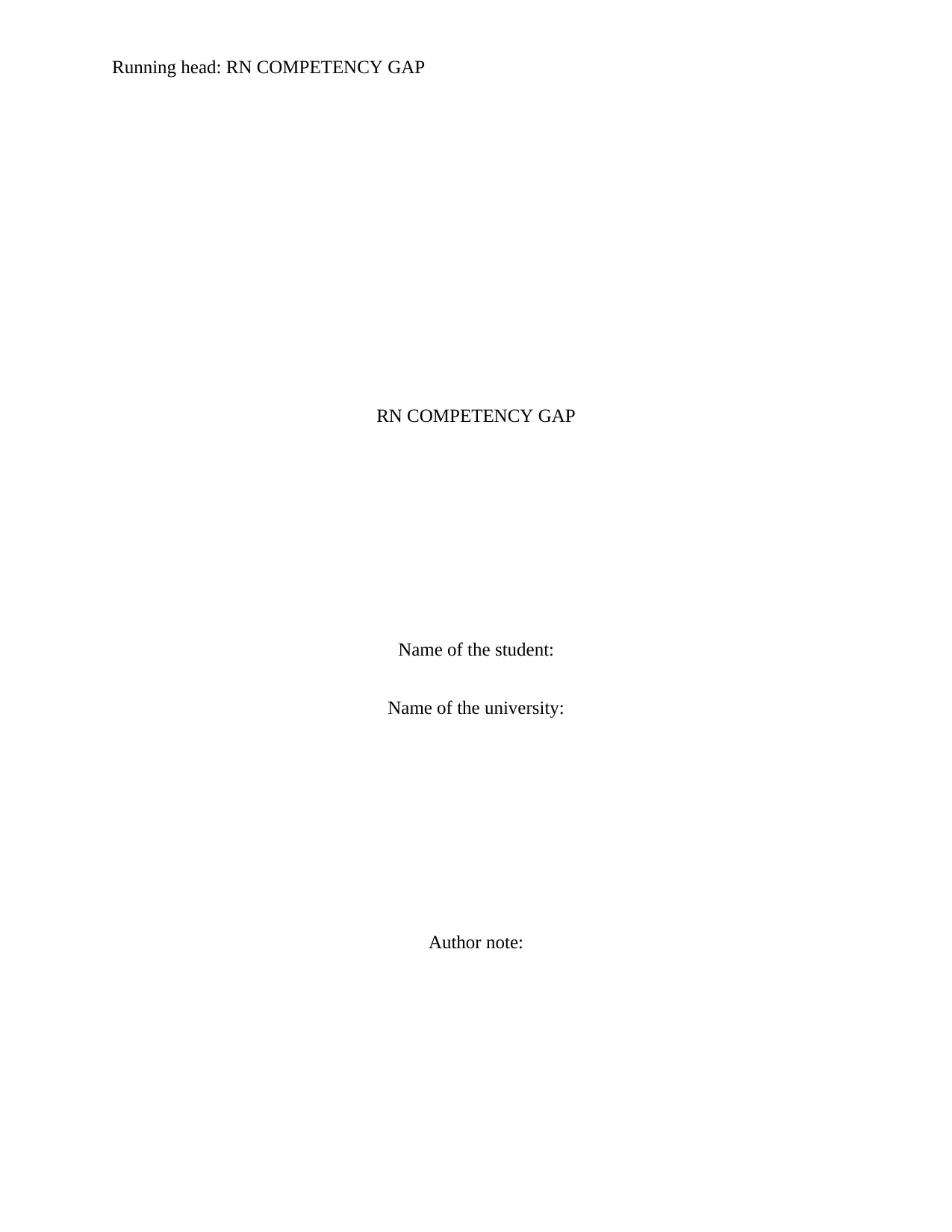
Running head: RN COMPETENCY GAP
RN COMPETENCY GAP
Name of the student:
Name of the university:
Author note:
RN COMPETENCY GAP
Name of the student:
Name of the university:
Author note:
Paraphrase This Document
Need a fresh take? Get an instant paraphrase of this document with our AI Paraphraser
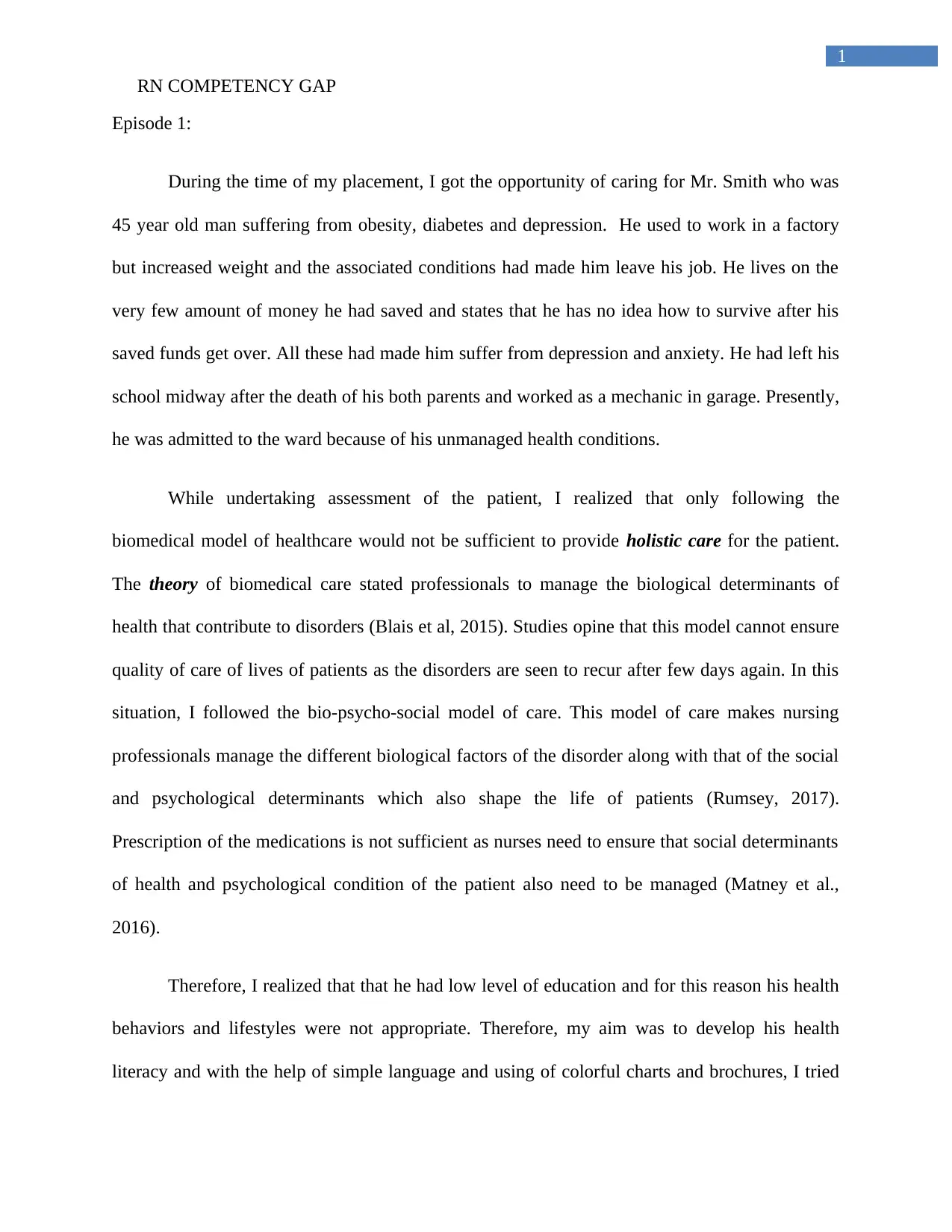
1
RN COMPETENCY GAP
Episode 1:
During the time of my placement, I got the opportunity of caring for Mr. Smith who was
45 year old man suffering from obesity, diabetes and depression. He used to work in a factory
but increased weight and the associated conditions had made him leave his job. He lives on the
very few amount of money he had saved and states that he has no idea how to survive after his
saved funds get over. All these had made him suffer from depression and anxiety. He had left his
school midway after the death of his both parents and worked as a mechanic in garage. Presently,
he was admitted to the ward because of his unmanaged health conditions.
While undertaking assessment of the patient, I realized that only following the
biomedical model of healthcare would not be sufficient to provide holistic care for the patient.
The theory of biomedical care stated professionals to manage the biological determinants of
health that contribute to disorders (Blais et al, 2015). Studies opine that this model cannot ensure
quality of care of lives of patients as the disorders are seen to recur after few days again. In this
situation, I followed the bio-psycho-social model of care. This model of care makes nursing
professionals manage the different biological factors of the disorder along with that of the social
and psychological determinants which also shape the life of patients (Rumsey, 2017).
Prescription of the medications is not sufficient as nurses need to ensure that social determinants
of health and psychological condition of the patient also need to be managed (Matney et al.,
2016).
Therefore, I realized that that he had low level of education and for this reason his health
behaviors and lifestyles were not appropriate. Therefore, my aim was to develop his health
literacy and with the help of simple language and using of colorful charts and brochures, I tried
RN COMPETENCY GAP
Episode 1:
During the time of my placement, I got the opportunity of caring for Mr. Smith who was
45 year old man suffering from obesity, diabetes and depression. He used to work in a factory
but increased weight and the associated conditions had made him leave his job. He lives on the
very few amount of money he had saved and states that he has no idea how to survive after his
saved funds get over. All these had made him suffer from depression and anxiety. He had left his
school midway after the death of his both parents and worked as a mechanic in garage. Presently,
he was admitted to the ward because of his unmanaged health conditions.
While undertaking assessment of the patient, I realized that only following the
biomedical model of healthcare would not be sufficient to provide holistic care for the patient.
The theory of biomedical care stated professionals to manage the biological determinants of
health that contribute to disorders (Blais et al, 2015). Studies opine that this model cannot ensure
quality of care of lives of patients as the disorders are seen to recur after few days again. In this
situation, I followed the bio-psycho-social model of care. This model of care makes nursing
professionals manage the different biological factors of the disorder along with that of the social
and psychological determinants which also shape the life of patients (Rumsey, 2017).
Prescription of the medications is not sufficient as nurses need to ensure that social determinants
of health and psychological condition of the patient also need to be managed (Matney et al.,
2016).
Therefore, I realized that that he had low level of education and for this reason his health
behaviors and lifestyles were not appropriate. Therefore, my aim was to develop his health
literacy and with the help of simple language and using of colorful charts and brochures, I tried
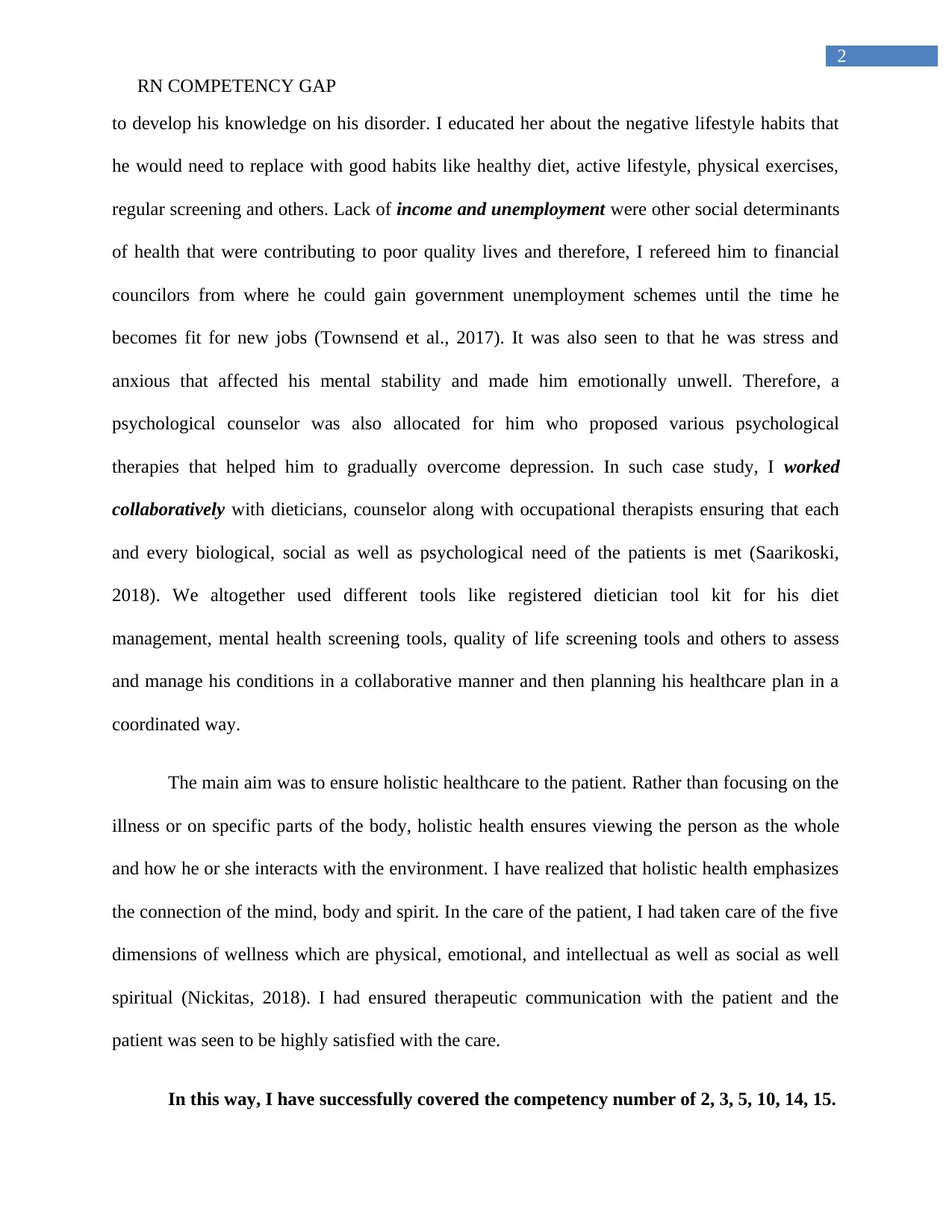
2
RN COMPETENCY GAP
to develop his knowledge on his disorder. I educated her about the negative lifestyle habits that
he would need to replace with good habits like healthy diet, active lifestyle, physical exercises,
regular screening and others. Lack of income and unemployment were other social determinants
of health that were contributing to poor quality lives and therefore, I refereed him to financial
councilors from where he could gain government unemployment schemes until the time he
becomes fit for new jobs (Townsend et al., 2017). It was also seen to that he was stress and
anxious that affected his mental stability and made him emotionally unwell. Therefore, a
psychological counselor was also allocated for him who proposed various psychological
therapies that helped him to gradually overcome depression. In such case study, I worked
collaboratively with dieticians, counselor along with occupational therapists ensuring that each
and every biological, social as well as psychological need of the patients is met (Saarikoski,
2018). We altogether used different tools like registered dietician tool kit for his diet
management, mental health screening tools, quality of life screening tools and others to assess
and manage his conditions in a collaborative manner and then planning his healthcare plan in a
coordinated way.
The main aim was to ensure holistic healthcare to the patient. Rather than focusing on the
illness or on specific parts of the body, holistic health ensures viewing the person as the whole
and how he or she interacts with the environment. I have realized that holistic health emphasizes
the connection of the mind, body and spirit. In the care of the patient, I had taken care of the five
dimensions of wellness which are physical, emotional, and intellectual as well as social as well
spiritual (Nickitas, 2018). I had ensured therapeutic communication with the patient and the
patient was seen to be highly satisfied with the care.
In this way, I have successfully covered the competency number of 2, 3, 5, 10, 14, 15.
RN COMPETENCY GAP
to develop his knowledge on his disorder. I educated her about the negative lifestyle habits that
he would need to replace with good habits like healthy diet, active lifestyle, physical exercises,
regular screening and others. Lack of income and unemployment were other social determinants
of health that were contributing to poor quality lives and therefore, I refereed him to financial
councilors from where he could gain government unemployment schemes until the time he
becomes fit for new jobs (Townsend et al., 2017). It was also seen to that he was stress and
anxious that affected his mental stability and made him emotionally unwell. Therefore, a
psychological counselor was also allocated for him who proposed various psychological
therapies that helped him to gradually overcome depression. In such case study, I worked
collaboratively with dieticians, counselor along with occupational therapists ensuring that each
and every biological, social as well as psychological need of the patients is met (Saarikoski,
2018). We altogether used different tools like registered dietician tool kit for his diet
management, mental health screening tools, quality of life screening tools and others to assess
and manage his conditions in a collaborative manner and then planning his healthcare plan in a
coordinated way.
The main aim was to ensure holistic healthcare to the patient. Rather than focusing on the
illness or on specific parts of the body, holistic health ensures viewing the person as the whole
and how he or she interacts with the environment. I have realized that holistic health emphasizes
the connection of the mind, body and spirit. In the care of the patient, I had taken care of the five
dimensions of wellness which are physical, emotional, and intellectual as well as social as well
spiritual (Nickitas, 2018). I had ensured therapeutic communication with the patient and the
patient was seen to be highly satisfied with the care.
In this way, I have successfully covered the competency number of 2, 3, 5, 10, 14, 15.
⊘ This is a preview!⊘
Do you want full access?
Subscribe today to unlock all pages.

Trusted by 1+ million students worldwide
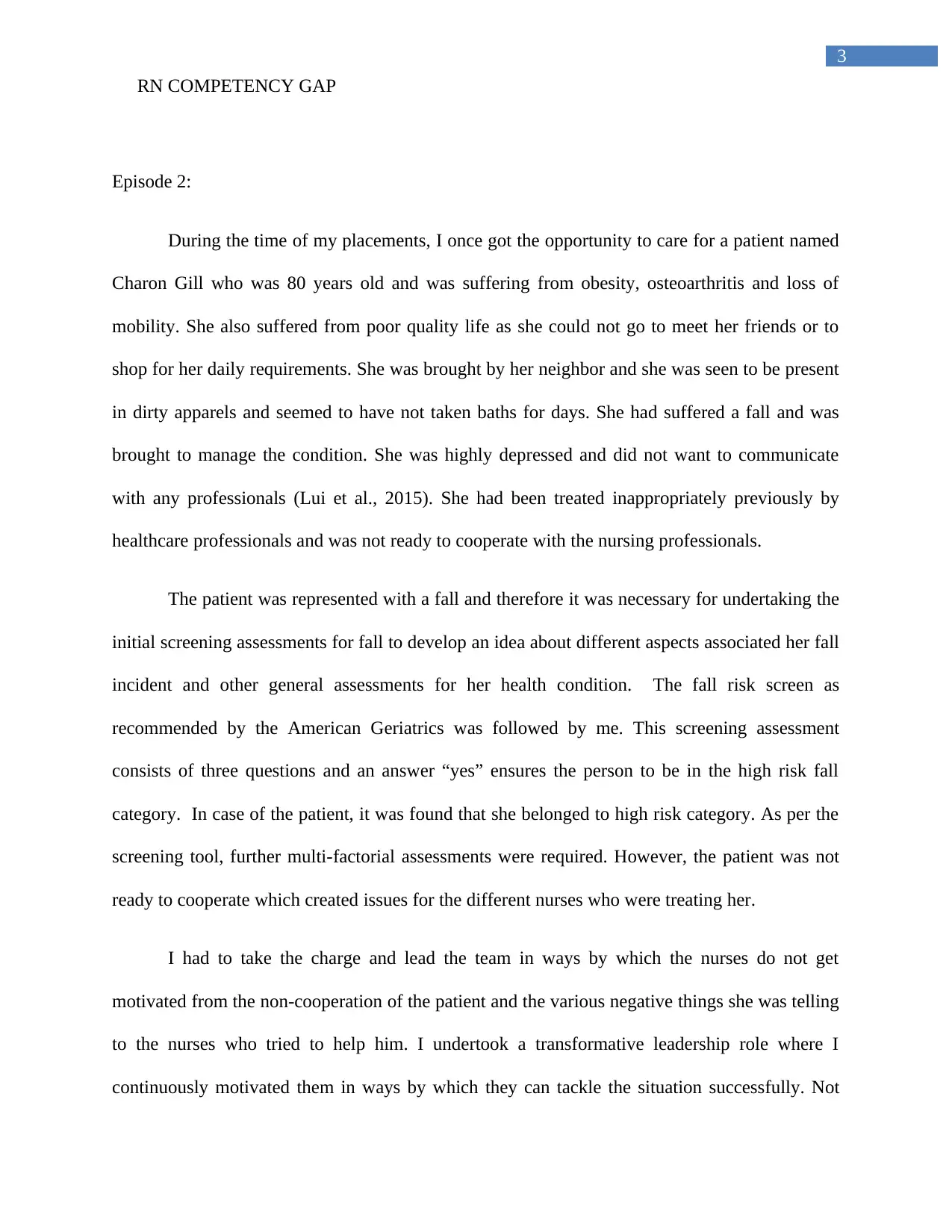
3
RN COMPETENCY GAP
Episode 2:
During the time of my placements, I once got the opportunity to care for a patient named
Charon Gill who was 80 years old and was suffering from obesity, osteoarthritis and loss of
mobility. She also suffered from poor quality life as she could not go to meet her friends or to
shop for her daily requirements. She was brought by her neighbor and she was seen to be present
in dirty apparels and seemed to have not taken baths for days. She had suffered a fall and was
brought to manage the condition. She was highly depressed and did not want to communicate
with any professionals (Lui et al., 2015). She had been treated inappropriately previously by
healthcare professionals and was not ready to cooperate with the nursing professionals.
The patient was represented with a fall and therefore it was necessary for undertaking the
initial screening assessments for fall to develop an idea about different aspects associated her fall
incident and other general assessments for her health condition. The fall risk screen as
recommended by the American Geriatrics was followed by me. This screening assessment
consists of three questions and an answer “yes” ensures the person to be in the high risk fall
category. In case of the patient, it was found that she belonged to high risk category. As per the
screening tool, further multi-factorial assessments were required. However, the patient was not
ready to cooperate which created issues for the different nurses who were treating her.
I had to take the charge and lead the team in ways by which the nurses do not get
motivated from the non-cooperation of the patient and the various negative things she was telling
to the nurses who tried to help him. I undertook a transformative leadership role where I
continuously motivated them in ways by which they can tackle the situation successfully. Not
RN COMPETENCY GAP
Episode 2:
During the time of my placements, I once got the opportunity to care for a patient named
Charon Gill who was 80 years old and was suffering from obesity, osteoarthritis and loss of
mobility. She also suffered from poor quality life as she could not go to meet her friends or to
shop for her daily requirements. She was brought by her neighbor and she was seen to be present
in dirty apparels and seemed to have not taken baths for days. She had suffered a fall and was
brought to manage the condition. She was highly depressed and did not want to communicate
with any professionals (Lui et al., 2015). She had been treated inappropriately previously by
healthcare professionals and was not ready to cooperate with the nursing professionals.
The patient was represented with a fall and therefore it was necessary for undertaking the
initial screening assessments for fall to develop an idea about different aspects associated her fall
incident and other general assessments for her health condition. The fall risk screen as
recommended by the American Geriatrics was followed by me. This screening assessment
consists of three questions and an answer “yes” ensures the person to be in the high risk fall
category. In case of the patient, it was found that she belonged to high risk category. As per the
screening tool, further multi-factorial assessments were required. However, the patient was not
ready to cooperate which created issues for the different nurses who were treating her.
I had to take the charge and lead the team in ways by which the nurses do not get
motivated from the non-cooperation of the patient and the various negative things she was telling
to the nurses who tried to help him. I undertook a transformative leadership role where I
continuously motivated them in ways by which they can tackle the situation successfully. Not
Paraphrase This Document
Need a fresh take? Get an instant paraphrase of this document with our AI Paraphraser
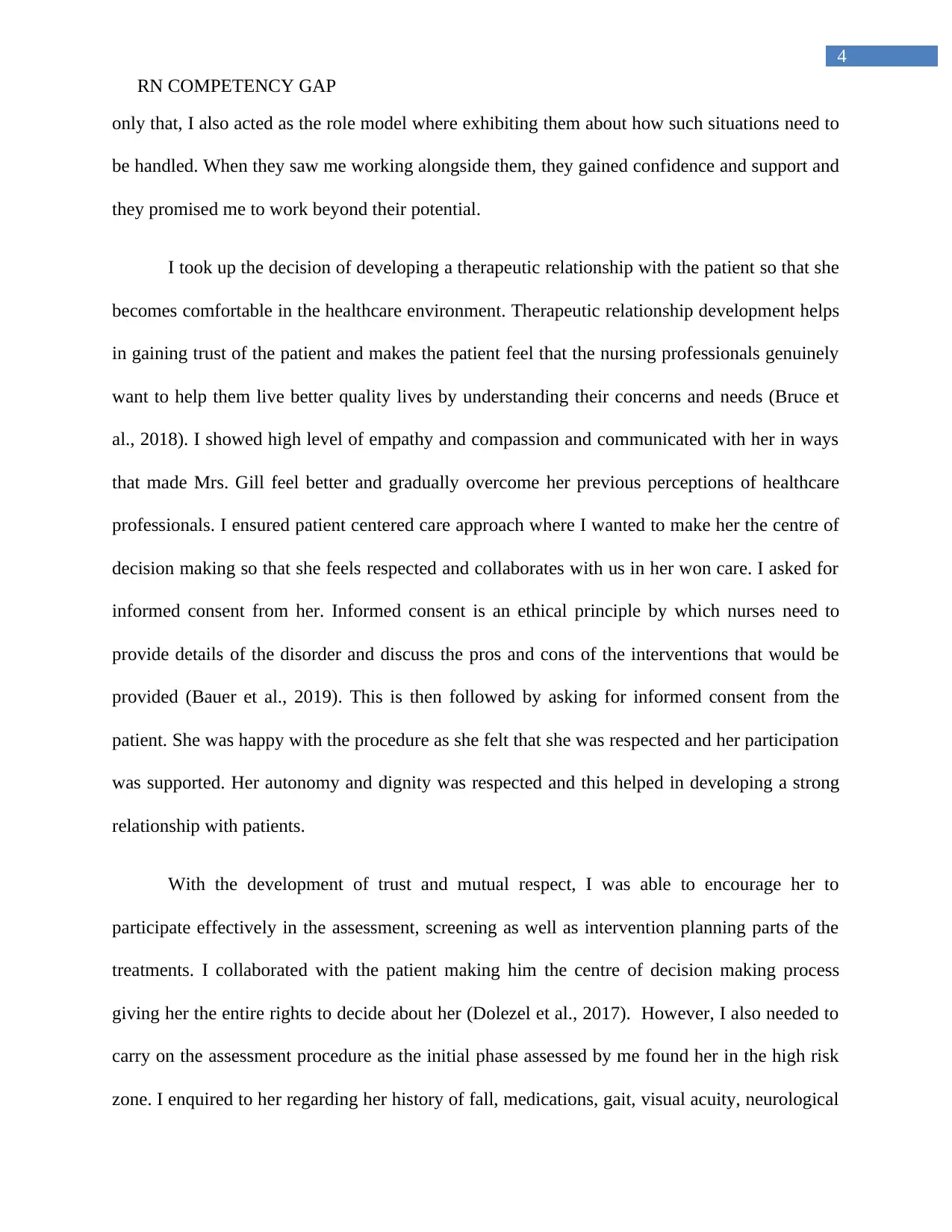
4
RN COMPETENCY GAP
only that, I also acted as the role model where exhibiting them about how such situations need to
be handled. When they saw me working alongside them, they gained confidence and support and
they promised me to work beyond their potential.
I took up the decision of developing a therapeutic relationship with the patient so that she
becomes comfortable in the healthcare environment. Therapeutic relationship development helps
in gaining trust of the patient and makes the patient feel that the nursing professionals genuinely
want to help them live better quality lives by understanding their concerns and needs (Bruce et
al., 2018). I showed high level of empathy and compassion and communicated with her in ways
that made Mrs. Gill feel better and gradually overcome her previous perceptions of healthcare
professionals. I ensured patient centered care approach where I wanted to make her the centre of
decision making so that she feels respected and collaborates with us in her won care. I asked for
informed consent from her. Informed consent is an ethical principle by which nurses need to
provide details of the disorder and discuss the pros and cons of the interventions that would be
provided (Bauer et al., 2019). This is then followed by asking for informed consent from the
patient. She was happy with the procedure as she felt that she was respected and her participation
was supported. Her autonomy and dignity was respected and this helped in developing a strong
relationship with patients.
With the development of trust and mutual respect, I was able to encourage her to
participate effectively in the assessment, screening as well as intervention planning parts of the
treatments. I collaborated with the patient making him the centre of decision making process
giving her the entire rights to decide about her (Dolezel et al., 2017). However, I also needed to
carry on the assessment procedure as the initial phase assessed by me found her in the high risk
zone. I enquired to her regarding her history of fall, medications, gait, visual acuity, neurological
RN COMPETENCY GAP
only that, I also acted as the role model where exhibiting them about how such situations need to
be handled. When they saw me working alongside them, they gained confidence and support and
they promised me to work beyond their potential.
I took up the decision of developing a therapeutic relationship with the patient so that she
becomes comfortable in the healthcare environment. Therapeutic relationship development helps
in gaining trust of the patient and makes the patient feel that the nursing professionals genuinely
want to help them live better quality lives by understanding their concerns and needs (Bruce et
al., 2018). I showed high level of empathy and compassion and communicated with her in ways
that made Mrs. Gill feel better and gradually overcome her previous perceptions of healthcare
professionals. I ensured patient centered care approach where I wanted to make her the centre of
decision making so that she feels respected and collaborates with us in her won care. I asked for
informed consent from her. Informed consent is an ethical principle by which nurses need to
provide details of the disorder and discuss the pros and cons of the interventions that would be
provided (Bauer et al., 2019). This is then followed by asking for informed consent from the
patient. She was happy with the procedure as she felt that she was respected and her participation
was supported. Her autonomy and dignity was respected and this helped in developing a strong
relationship with patients.
With the development of trust and mutual respect, I was able to encourage her to
participate effectively in the assessment, screening as well as intervention planning parts of the
treatments. I collaborated with the patient making him the centre of decision making process
giving her the entire rights to decide about her (Dolezel et al., 2017). However, I also needed to
carry on the assessment procedure as the initial phase assessed by me found her in the high risk
zone. I enquired to her regarding her history of fall, medications, gait, visual acuity, neurological
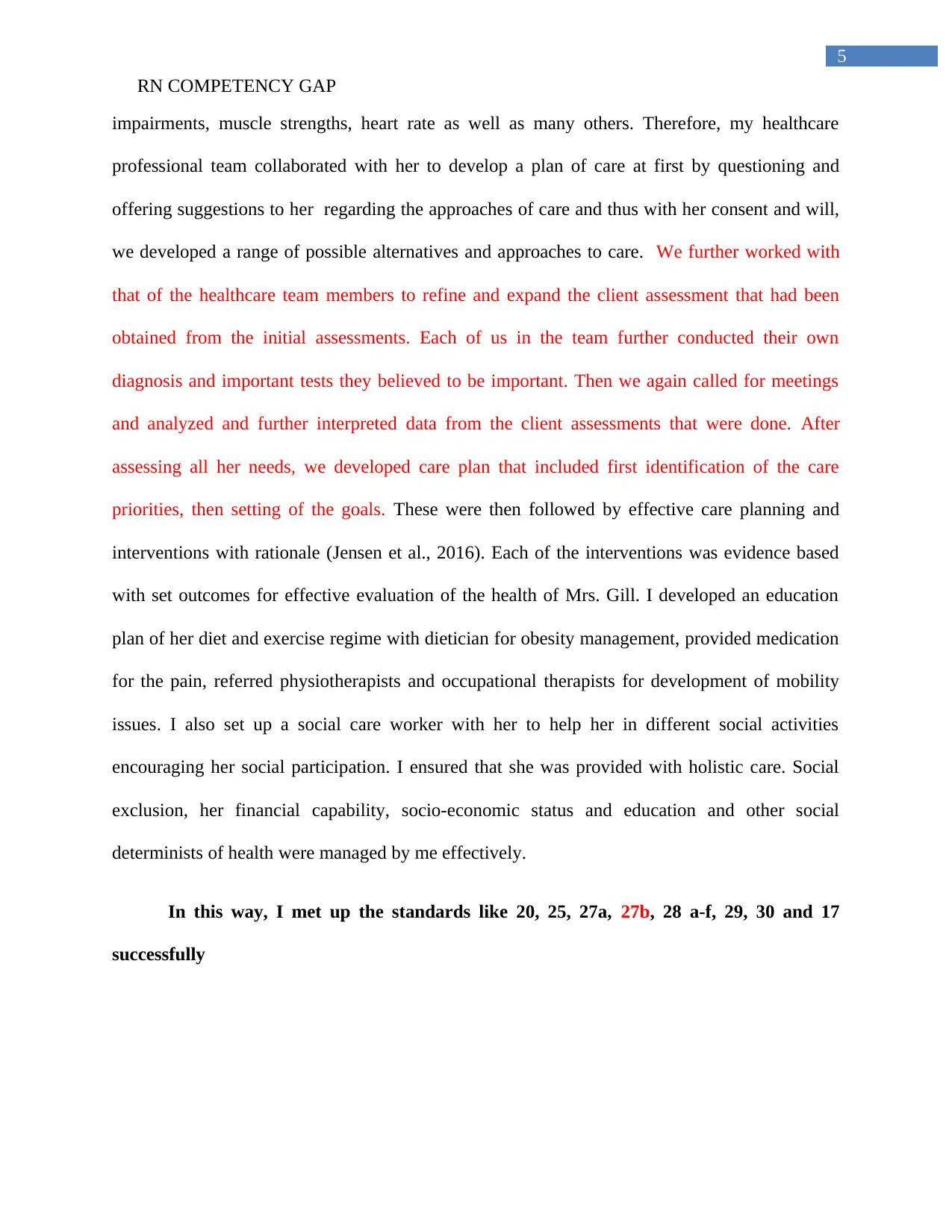
5
RN COMPETENCY GAP
impairments, muscle strengths, heart rate as well as many others. Therefore, my healthcare
professional team collaborated with her to develop a plan of care at first by questioning and
offering suggestions to her regarding the approaches of care and thus with her consent and will,
we developed a range of possible alternatives and approaches to care. We further worked with
that of the healthcare team members to refine and expand the client assessment that had been
obtained from the initial assessments. Each of us in the team further conducted their own
diagnosis and important tests they believed to be important. Then we again called for meetings
and analyzed and further interpreted data from the client assessments that were done. After
assessing all her needs, we developed care plan that included first identification of the care
priorities, then setting of the goals. These were then followed by effective care planning and
interventions with rationale (Jensen et al., 2016). Each of the interventions was evidence based
with set outcomes for effective evaluation of the health of Mrs. Gill. I developed an education
plan of her diet and exercise regime with dietician for obesity management, provided medication
for the pain, referred physiotherapists and occupational therapists for development of mobility
issues. I also set up a social care worker with her to help her in different social activities
encouraging her social participation. I ensured that she was provided with holistic care. Social
exclusion, her financial capability, socio-economic status and education and other social
determinists of health were managed by me effectively.
In this way, I met up the standards like 20, 25, 27a, 27b, 28 a-f, 29, 30 and 17
successfully
RN COMPETENCY GAP
impairments, muscle strengths, heart rate as well as many others. Therefore, my healthcare
professional team collaborated with her to develop a plan of care at first by questioning and
offering suggestions to her regarding the approaches of care and thus with her consent and will,
we developed a range of possible alternatives and approaches to care. We further worked with
that of the healthcare team members to refine and expand the client assessment that had been
obtained from the initial assessments. Each of us in the team further conducted their own
diagnosis and important tests they believed to be important. Then we again called for meetings
and analyzed and further interpreted data from the client assessments that were done. After
assessing all her needs, we developed care plan that included first identification of the care
priorities, then setting of the goals. These were then followed by effective care planning and
interventions with rationale (Jensen et al., 2016). Each of the interventions was evidence based
with set outcomes for effective evaluation of the health of Mrs. Gill. I developed an education
plan of her diet and exercise regime with dietician for obesity management, provided medication
for the pain, referred physiotherapists and occupational therapists for development of mobility
issues. I also set up a social care worker with her to help her in different social activities
encouraging her social participation. I ensured that she was provided with holistic care. Social
exclusion, her financial capability, socio-economic status and education and other social
determinists of health were managed by me effectively.
In this way, I met up the standards like 20, 25, 27a, 27b, 28 a-f, 29, 30 and 17
successfully
⊘ This is a preview!⊘
Do you want full access?
Subscribe today to unlock all pages.

Trusted by 1+ million students worldwide
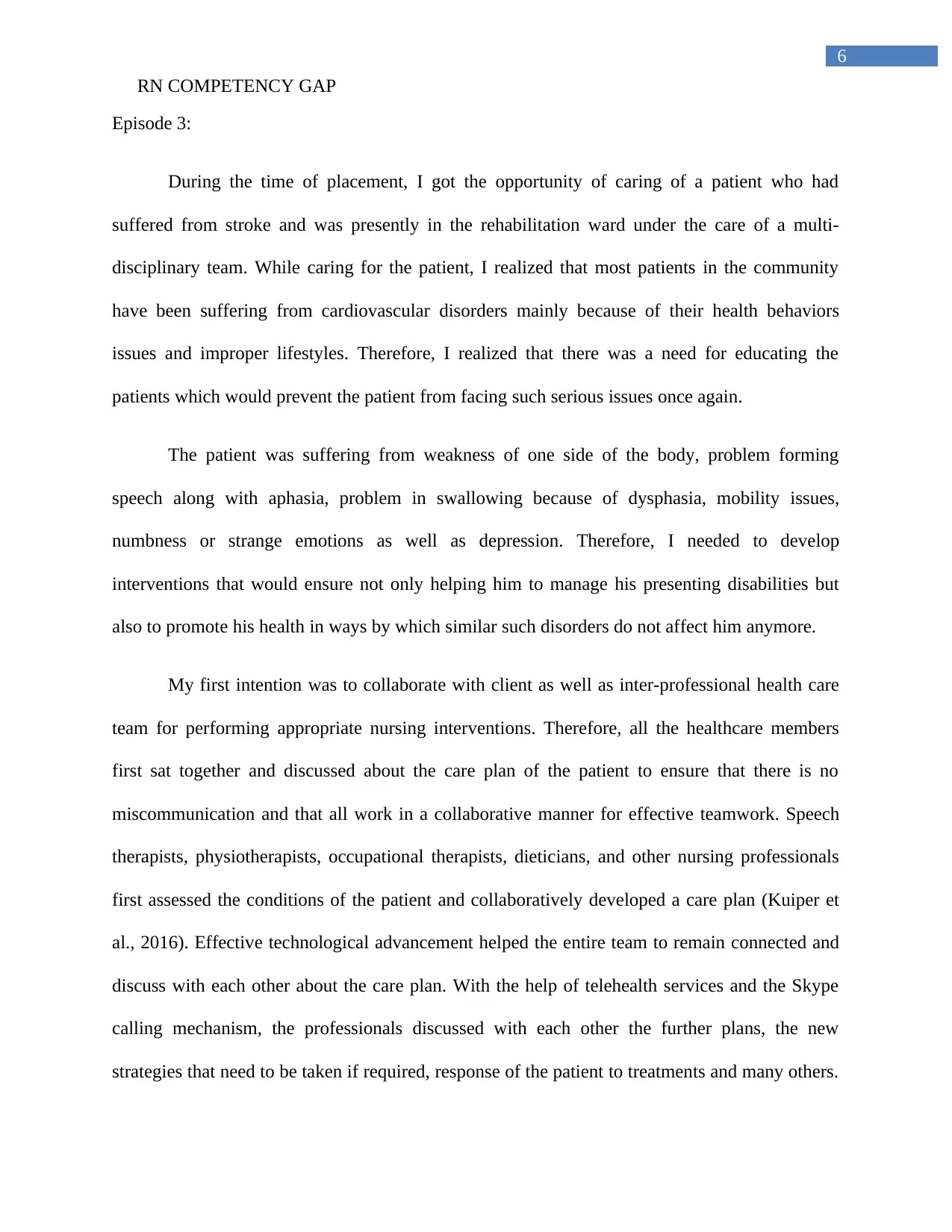
6
RN COMPETENCY GAP
Episode 3:
During the time of placement, I got the opportunity of caring of a patient who had
suffered from stroke and was presently in the rehabilitation ward under the care of a multi-
disciplinary team. While caring for the patient, I realized that most patients in the community
have been suffering from cardiovascular disorders mainly because of their health behaviors
issues and improper lifestyles. Therefore, I realized that there was a need for educating the
patients which would prevent the patient from facing such serious issues once again.
The patient was suffering from weakness of one side of the body, problem forming
speech along with aphasia, problem in swallowing because of dysphasia, mobility issues,
numbness or strange emotions as well as depression. Therefore, I needed to develop
interventions that would ensure not only helping him to manage his presenting disabilities but
also to promote his health in ways by which similar such disorders do not affect him anymore.
My first intention was to collaborate with client as well as inter-professional health care
team for performing appropriate nursing interventions. Therefore, all the healthcare members
first sat together and discussed about the care plan of the patient to ensure that there is no
miscommunication and that all work in a collaborative manner for effective teamwork. Speech
therapists, physiotherapists, occupational therapists, dieticians, and other nursing professionals
first assessed the conditions of the patient and collaboratively developed a care plan (Kuiper et
al., 2016). Effective technological advancement helped the entire team to remain connected and
discuss with each other about the care plan. With the help of telehealth services and the Skype
calling mechanism, the professionals discussed with each other the further plans, the new
strategies that need to be taken if required, response of the patient to treatments and many others.
RN COMPETENCY GAP
Episode 3:
During the time of placement, I got the opportunity of caring of a patient who had
suffered from stroke and was presently in the rehabilitation ward under the care of a multi-
disciplinary team. While caring for the patient, I realized that most patients in the community
have been suffering from cardiovascular disorders mainly because of their health behaviors
issues and improper lifestyles. Therefore, I realized that there was a need for educating the
patients which would prevent the patient from facing such serious issues once again.
The patient was suffering from weakness of one side of the body, problem forming
speech along with aphasia, problem in swallowing because of dysphasia, mobility issues,
numbness or strange emotions as well as depression. Therefore, I needed to develop
interventions that would ensure not only helping him to manage his presenting disabilities but
also to promote his health in ways by which similar such disorders do not affect him anymore.
My first intention was to collaborate with client as well as inter-professional health care
team for performing appropriate nursing interventions. Therefore, all the healthcare members
first sat together and discussed about the care plan of the patient to ensure that there is no
miscommunication and that all work in a collaborative manner for effective teamwork. Speech
therapists, physiotherapists, occupational therapists, dieticians, and other nursing professionals
first assessed the conditions of the patient and collaboratively developed a care plan (Kuiper et
al., 2016). Effective technological advancement helped the entire team to remain connected and
discuss with each other about the care plan. With the help of telehealth services and the Skype
calling mechanism, the professionals discussed with each other the further plans, the new
strategies that need to be taken if required, response of the patient to treatments and many others.
Paraphrase This Document
Need a fresh take? Get an instant paraphrase of this document with our AI Paraphraser
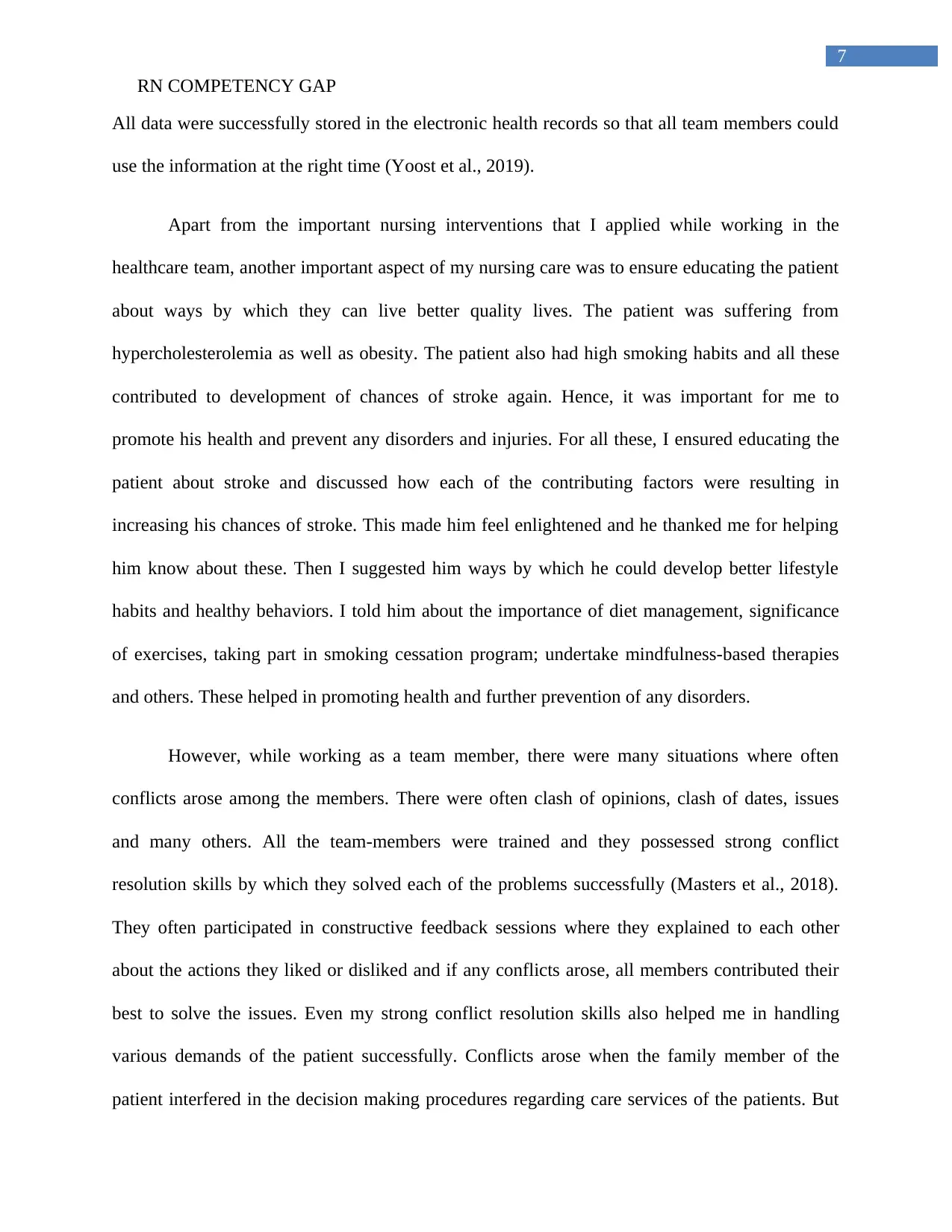
7
RN COMPETENCY GAP
All data were successfully stored in the electronic health records so that all team members could
use the information at the right time (Yoost et al., 2019).
Apart from the important nursing interventions that I applied while working in the
healthcare team, another important aspect of my nursing care was to ensure educating the patient
about ways by which they can live better quality lives. The patient was suffering from
hypercholesterolemia as well as obesity. The patient also had high smoking habits and all these
contributed to development of chances of stroke again. Hence, it was important for me to
promote his health and prevent any disorders and injuries. For all these, I ensured educating the
patient about stroke and discussed how each of the contributing factors were resulting in
increasing his chances of stroke. This made him feel enlightened and he thanked me for helping
him know about these. Then I suggested him ways by which he could develop better lifestyle
habits and healthy behaviors. I told him about the importance of diet management, significance
of exercises, taking part in smoking cessation program; undertake mindfulness-based therapies
and others. These helped in promoting health and further prevention of any disorders.
However, while working as a team member, there were many situations where often
conflicts arose among the members. There were often clash of opinions, clash of dates, issues
and many others. All the team-members were trained and they possessed strong conflict
resolution skills by which they solved each of the problems successfully (Masters et al., 2018).
They often participated in constructive feedback sessions where they explained to each other
about the actions they liked or disliked and if any conflicts arose, all members contributed their
best to solve the issues. Even my strong conflict resolution skills also helped me in handling
various demands of the patient successfully. Conflicts arose when the family member of the
patient interfered in the decision making procedures regarding care services of the patients. But
RN COMPETENCY GAP
All data were successfully stored in the electronic health records so that all team members could
use the information at the right time (Yoost et al., 2019).
Apart from the important nursing interventions that I applied while working in the
healthcare team, another important aspect of my nursing care was to ensure educating the patient
about ways by which they can live better quality lives. The patient was suffering from
hypercholesterolemia as well as obesity. The patient also had high smoking habits and all these
contributed to development of chances of stroke again. Hence, it was important for me to
promote his health and prevent any disorders and injuries. For all these, I ensured educating the
patient about stroke and discussed how each of the contributing factors were resulting in
increasing his chances of stroke. This made him feel enlightened and he thanked me for helping
him know about these. Then I suggested him ways by which he could develop better lifestyle
habits and healthy behaviors. I told him about the importance of diet management, significance
of exercises, taking part in smoking cessation program; undertake mindfulness-based therapies
and others. These helped in promoting health and further prevention of any disorders.
However, while working as a team member, there were many situations where often
conflicts arose among the members. There were often clash of opinions, clash of dates, issues
and many others. All the team-members were trained and they possessed strong conflict
resolution skills by which they solved each of the problems successfully (Masters et al., 2018).
They often participated in constructive feedback sessions where they explained to each other
about the actions they liked or disliked and if any conflicts arose, all members contributed their
best to solve the issues. Even my strong conflict resolution skills also helped me in handling
various demands of the patient successfully. Conflicts arose when the family member of the
patient interfered in the decision making procedures regarding care services of the patients. But
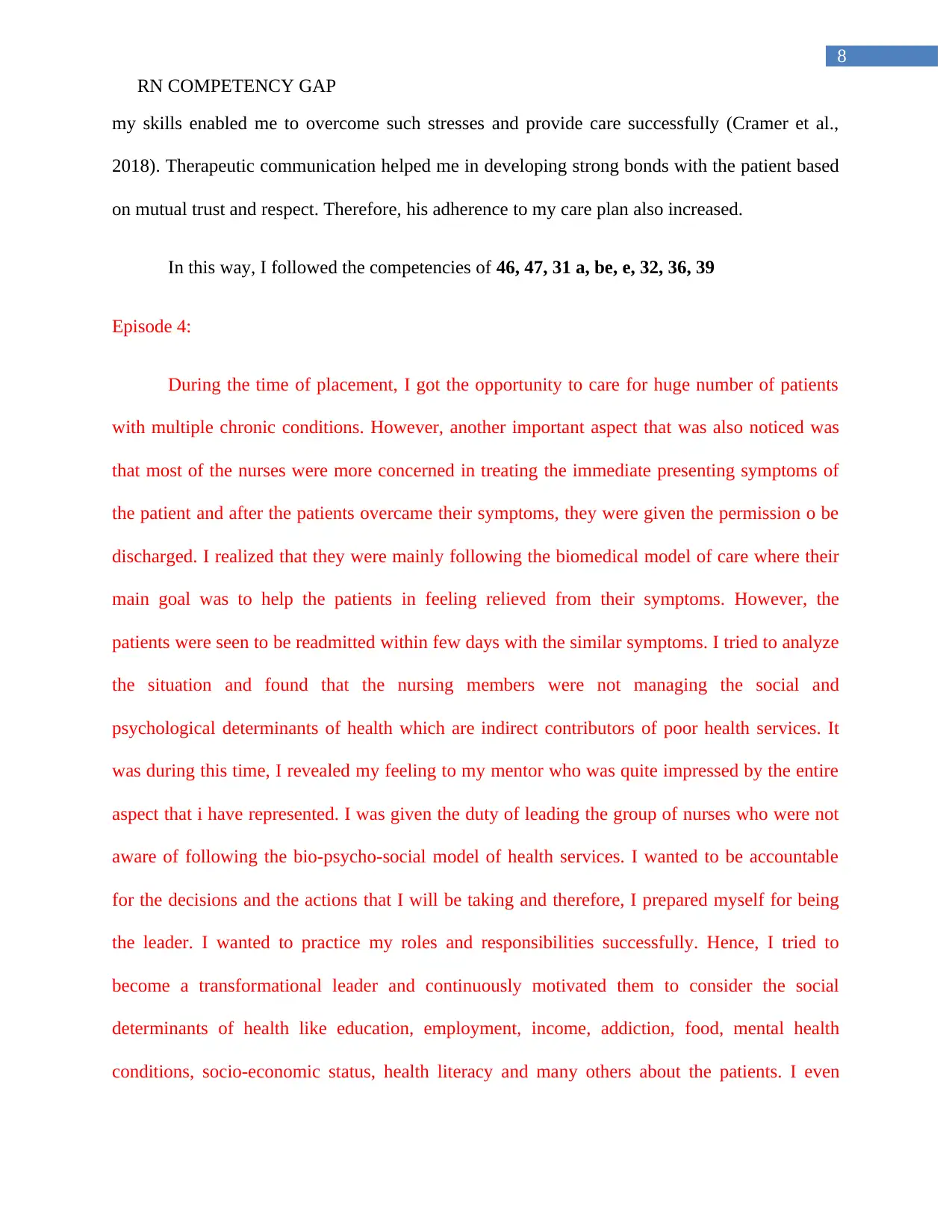
8
RN COMPETENCY GAP
my skills enabled me to overcome such stresses and provide care successfully (Cramer et al.,
2018). Therapeutic communication helped me in developing strong bonds with the patient based
on mutual trust and respect. Therefore, his adherence to my care plan also increased.
In this way, I followed the competencies of 46, 47, 31 a, be, e, 32, 36, 39
Episode 4:
During the time of placement, I got the opportunity to care for huge number of patients
with multiple chronic conditions. However, another important aspect that was also noticed was
that most of the nurses were more concerned in treating the immediate presenting symptoms of
the patient and after the patients overcame their symptoms, they were given the permission o be
discharged. I realized that they were mainly following the biomedical model of care where their
main goal was to help the patients in feeling relieved from their symptoms. However, the
patients were seen to be readmitted within few days with the similar symptoms. I tried to analyze
the situation and found that the nursing members were not managing the social and
psychological determinants of health which are indirect contributors of poor health services. It
was during this time, I revealed my feeling to my mentor who was quite impressed by the entire
aspect that i have represented. I was given the duty of leading the group of nurses who were not
aware of following the bio-psycho-social model of health services. I wanted to be accountable
for the decisions and the actions that I will be taking and therefore, I prepared myself for being
the leader. I wanted to practice my roles and responsibilities successfully. Hence, I tried to
become a transformational leader and continuously motivated them to consider the social
determinants of health like education, employment, income, addiction, food, mental health
conditions, socio-economic status, health literacy and many others about the patients. I even
RN COMPETENCY GAP
my skills enabled me to overcome such stresses and provide care successfully (Cramer et al.,
2018). Therapeutic communication helped me in developing strong bonds with the patient based
on mutual trust and respect. Therefore, his adherence to my care plan also increased.
In this way, I followed the competencies of 46, 47, 31 a, be, e, 32, 36, 39
Episode 4:
During the time of placement, I got the opportunity to care for huge number of patients
with multiple chronic conditions. However, another important aspect that was also noticed was
that most of the nurses were more concerned in treating the immediate presenting symptoms of
the patient and after the patients overcame their symptoms, they were given the permission o be
discharged. I realized that they were mainly following the biomedical model of care where their
main goal was to help the patients in feeling relieved from their symptoms. However, the
patients were seen to be readmitted within few days with the similar symptoms. I tried to analyze
the situation and found that the nursing members were not managing the social and
psychological determinants of health which are indirect contributors of poor health services. It
was during this time, I revealed my feeling to my mentor who was quite impressed by the entire
aspect that i have represented. I was given the duty of leading the group of nurses who were not
aware of following the bio-psycho-social model of health services. I wanted to be accountable
for the decisions and the actions that I will be taking and therefore, I prepared myself for being
the leader. I wanted to practice my roles and responsibilities successfully. Hence, I tried to
become a transformational leader and continuously motivated them to consider the social
determinants of health like education, employment, income, addiction, food, mental health
conditions, socio-economic status, health literacy and many others about the patients. I even
⊘ This is a preview!⊘
Do you want full access?
Subscribe today to unlock all pages.

Trusted by 1+ million students worldwide
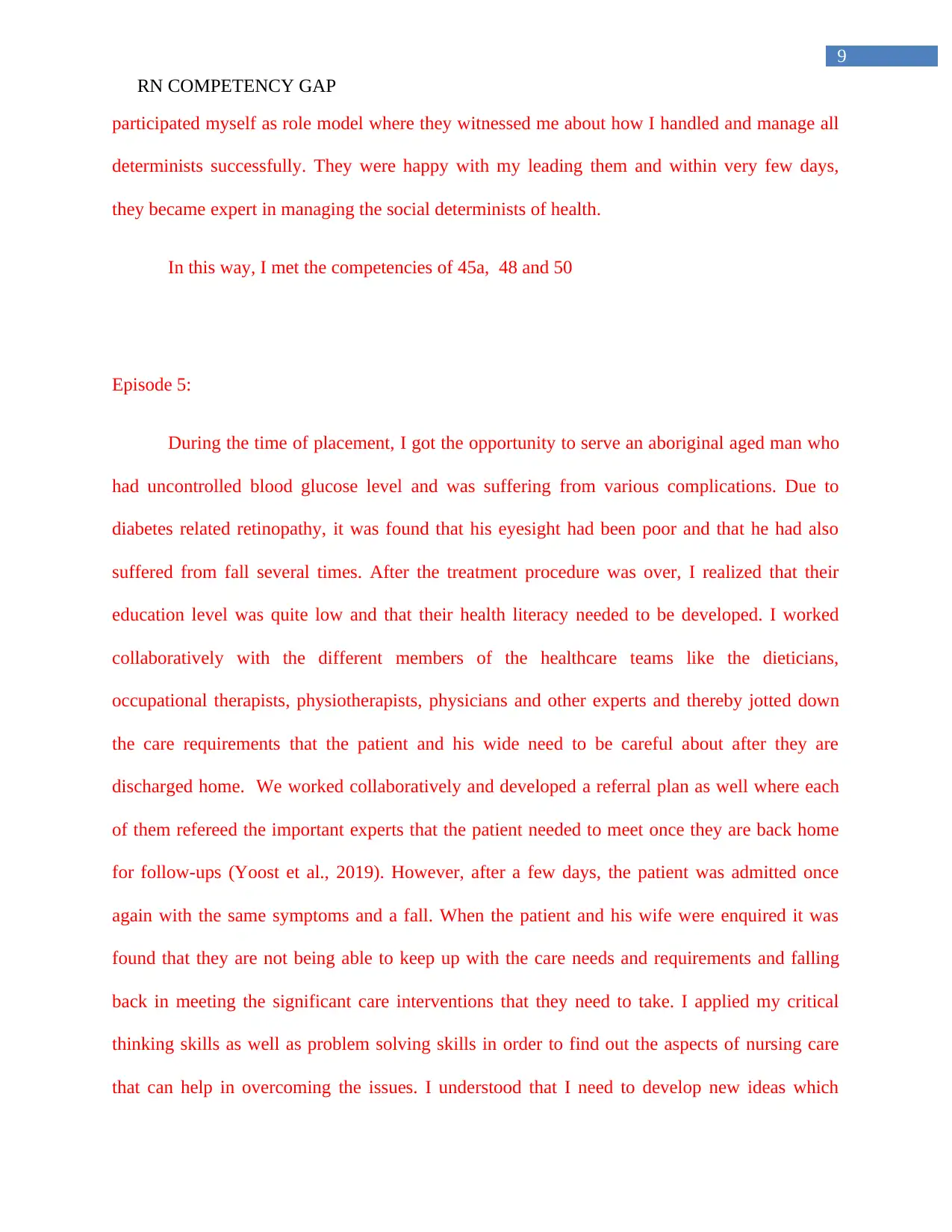
9
RN COMPETENCY GAP
participated myself as role model where they witnessed me about how I handled and manage all
determinists successfully. They were happy with my leading them and within very few days,
they became expert in managing the social determinists of health.
In this way, I met the competencies of 45a, 48 and 50
Episode 5:
During the time of placement, I got the opportunity to serve an aboriginal aged man who
had uncontrolled blood glucose level and was suffering from various complications. Due to
diabetes related retinopathy, it was found that his eyesight had been poor and that he had also
suffered from fall several times. After the treatment procedure was over, I realized that their
education level was quite low and that their health literacy needed to be developed. I worked
collaboratively with the different members of the healthcare teams like the dieticians,
occupational therapists, physiotherapists, physicians and other experts and thereby jotted down
the care requirements that the patient and his wide need to be careful about after they are
discharged home. We worked collaboratively and developed a referral plan as well where each
of them refereed the important experts that the patient needed to meet once they are back home
for follow-ups (Yoost et al., 2019). However, after a few days, the patient was admitted once
again with the same symptoms and a fall. When the patient and his wife were enquired it was
found that they are not being able to keep up with the care needs and requirements and falling
back in meeting the significant care interventions that they need to take. I applied my critical
thinking skills as well as problem solving skills in order to find out the aspects of nursing care
that can help in overcoming the issues. I understood that I need to develop new ideas which
RN COMPETENCY GAP
participated myself as role model where they witnessed me about how I handled and manage all
determinists successfully. They were happy with my leading them and within very few days,
they became expert in managing the social determinists of health.
In this way, I met the competencies of 45a, 48 and 50
Episode 5:
During the time of placement, I got the opportunity to serve an aboriginal aged man who
had uncontrolled blood glucose level and was suffering from various complications. Due to
diabetes related retinopathy, it was found that his eyesight had been poor and that he had also
suffered from fall several times. After the treatment procedure was over, I realized that their
education level was quite low and that their health literacy needed to be developed. I worked
collaboratively with the different members of the healthcare teams like the dieticians,
occupational therapists, physiotherapists, physicians and other experts and thereby jotted down
the care requirements that the patient and his wide need to be careful about after they are
discharged home. We worked collaboratively and developed a referral plan as well where each
of them refereed the important experts that the patient needed to meet once they are back home
for follow-ups (Yoost et al., 2019). However, after a few days, the patient was admitted once
again with the same symptoms and a fall. When the patient and his wife were enquired it was
found that they are not being able to keep up with the care needs and requirements and falling
back in meeting the significant care interventions that they need to take. I applied my critical
thinking skills as well as problem solving skills in order to find out the aspects of nursing care
that can help in overcoming the issues. I understood that I need to develop new ideas which
Paraphrase This Document
Need a fresh take? Get an instant paraphrase of this document with our AI Paraphraser
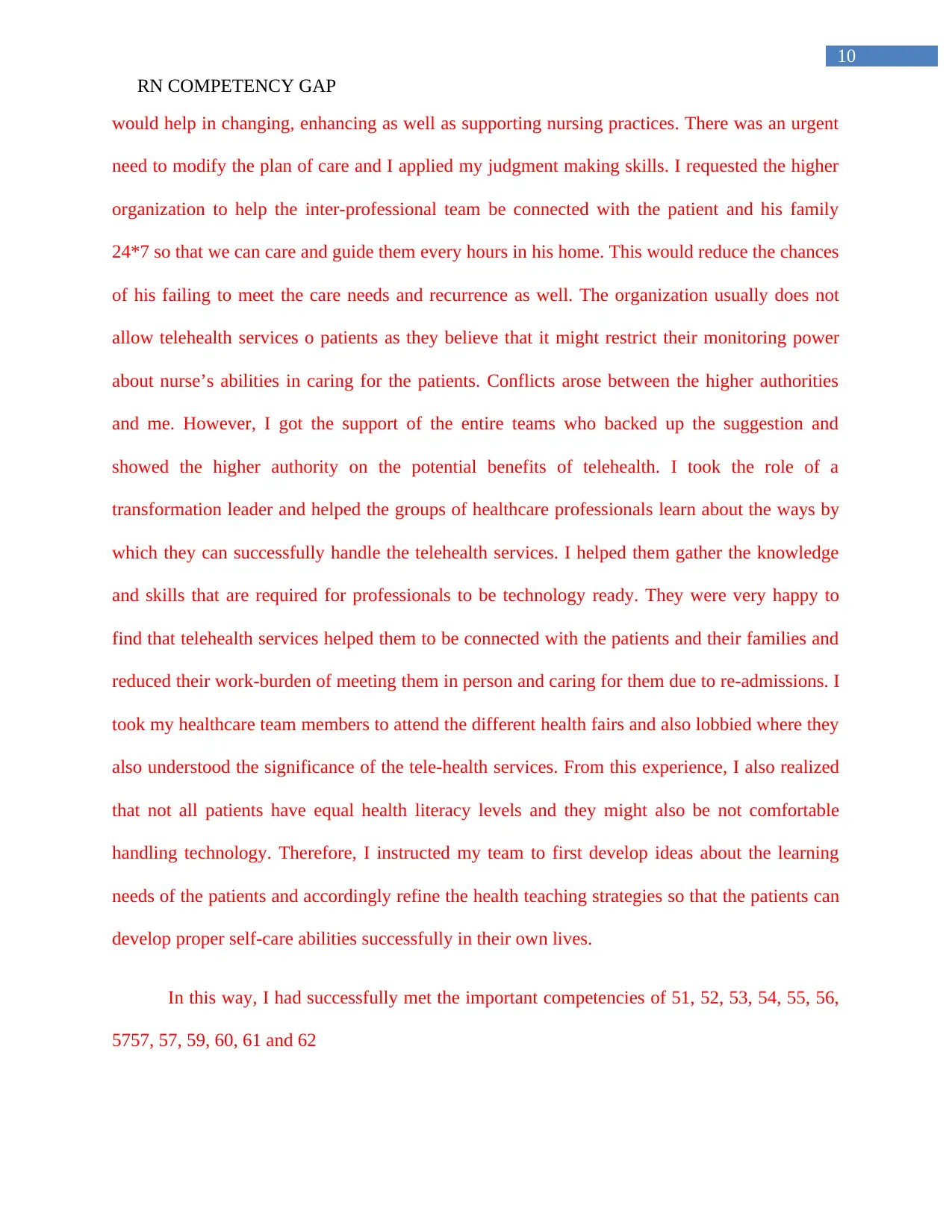
10
RN COMPETENCY GAP
would help in changing, enhancing as well as supporting nursing practices. There was an urgent
need to modify the plan of care and I applied my judgment making skills. I requested the higher
organization to help the inter-professional team be connected with the patient and his family
24*7 so that we can care and guide them every hours in his home. This would reduce the chances
of his failing to meet the care needs and recurrence as well. The organization usually does not
allow telehealth services o patients as they believe that it might restrict their monitoring power
about nurse’s abilities in caring for the patients. Conflicts arose between the higher authorities
and me. However, I got the support of the entire teams who backed up the suggestion and
showed the higher authority on the potential benefits of telehealth. I took the role of a
transformation leader and helped the groups of healthcare professionals learn about the ways by
which they can successfully handle the telehealth services. I helped them gather the knowledge
and skills that are required for professionals to be technology ready. They were very happy to
find that telehealth services helped them to be connected with the patients and their families and
reduced their work-burden of meeting them in person and caring for them due to re-admissions. I
took my healthcare team members to attend the different health fairs and also lobbied where they
also understood the significance of the tele-health services. From this experience, I also realized
that not all patients have equal health literacy levels and they might also be not comfortable
handling technology. Therefore, I instructed my team to first develop ideas about the learning
needs of the patients and accordingly refine the health teaching strategies so that the patients can
develop proper self-care abilities successfully in their own lives.
In this way, I had successfully met the important competencies of 51, 52, 53, 54, 55, 56,
5757, 57, 59, 60, 61 and 62
RN COMPETENCY GAP
would help in changing, enhancing as well as supporting nursing practices. There was an urgent
need to modify the plan of care and I applied my judgment making skills. I requested the higher
organization to help the inter-professional team be connected with the patient and his family
24*7 so that we can care and guide them every hours in his home. This would reduce the chances
of his failing to meet the care needs and recurrence as well. The organization usually does not
allow telehealth services o patients as they believe that it might restrict their monitoring power
about nurse’s abilities in caring for the patients. Conflicts arose between the higher authorities
and me. However, I got the support of the entire teams who backed up the suggestion and
showed the higher authority on the potential benefits of telehealth. I took the role of a
transformation leader and helped the groups of healthcare professionals learn about the ways by
which they can successfully handle the telehealth services. I helped them gather the knowledge
and skills that are required for professionals to be technology ready. They were very happy to
find that telehealth services helped them to be connected with the patients and their families and
reduced their work-burden of meeting them in person and caring for them due to re-admissions. I
took my healthcare team members to attend the different health fairs and also lobbied where they
also understood the significance of the tele-health services. From this experience, I also realized
that not all patients have equal health literacy levels and they might also be not comfortable
handling technology. Therefore, I instructed my team to first develop ideas about the learning
needs of the patients and accordingly refine the health teaching strategies so that the patients can
develop proper self-care abilities successfully in their own lives.
In this way, I had successfully met the important competencies of 51, 52, 53, 54, 55, 56,
5757, 57, 59, 60, 61 and 62
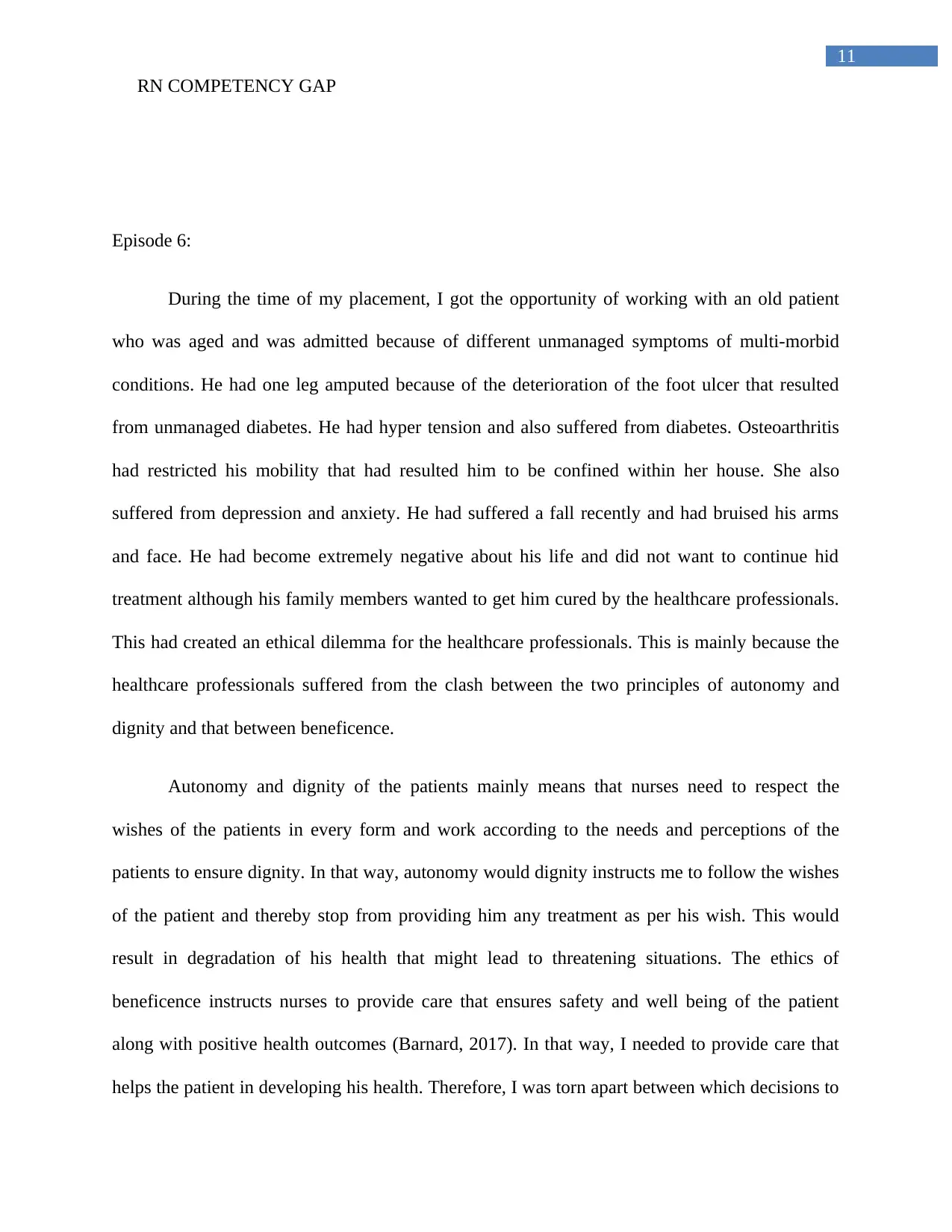
11
RN COMPETENCY GAP
Episode 6:
During the time of my placement, I got the opportunity of working with an old patient
who was aged and was admitted because of different unmanaged symptoms of multi-morbid
conditions. He had one leg amputed because of the deterioration of the foot ulcer that resulted
from unmanaged diabetes. He had hyper tension and also suffered from diabetes. Osteoarthritis
had restricted his mobility that had resulted him to be confined within her house. She also
suffered from depression and anxiety. He had suffered a fall recently and had bruised his arms
and face. He had become extremely negative about his life and did not want to continue hid
treatment although his family members wanted to get him cured by the healthcare professionals.
This had created an ethical dilemma for the healthcare professionals. This is mainly because the
healthcare professionals suffered from the clash between the two principles of autonomy and
dignity and that between beneficence.
Autonomy and dignity of the patients mainly means that nurses need to respect the
wishes of the patients in every form and work according to the needs and perceptions of the
patients to ensure dignity. In that way, autonomy would dignity instructs me to follow the wishes
of the patient and thereby stop from providing him any treatment as per his wish. This would
result in degradation of his health that might lead to threatening situations. The ethics of
beneficence instructs nurses to provide care that ensures safety and well being of the patient
along with positive health outcomes (Barnard, 2017). In that way, I needed to provide care that
helps the patient in developing his health. Therefore, I was torn apart between which decisions to
RN COMPETENCY GAP
Episode 6:
During the time of my placement, I got the opportunity of working with an old patient
who was aged and was admitted because of different unmanaged symptoms of multi-morbid
conditions. He had one leg amputed because of the deterioration of the foot ulcer that resulted
from unmanaged diabetes. He had hyper tension and also suffered from diabetes. Osteoarthritis
had restricted his mobility that had resulted him to be confined within her house. She also
suffered from depression and anxiety. He had suffered a fall recently and had bruised his arms
and face. He had become extremely negative about his life and did not want to continue hid
treatment although his family members wanted to get him cured by the healthcare professionals.
This had created an ethical dilemma for the healthcare professionals. This is mainly because the
healthcare professionals suffered from the clash between the two principles of autonomy and
dignity and that between beneficence.
Autonomy and dignity of the patients mainly means that nurses need to respect the
wishes of the patients in every form and work according to the needs and perceptions of the
patients to ensure dignity. In that way, autonomy would dignity instructs me to follow the wishes
of the patient and thereby stop from providing him any treatment as per his wish. This would
result in degradation of his health that might lead to threatening situations. The ethics of
beneficence instructs nurses to provide care that ensures safety and well being of the patient
along with positive health outcomes (Barnard, 2017). In that way, I needed to provide care that
helps the patient in developing his health. Therefore, I was torn apart between which decisions to
⊘ This is a preview!⊘
Do you want full access?
Subscribe today to unlock all pages.

Trusted by 1+ million students worldwide
1 out of 35
Related Documents
Your All-in-One AI-Powered Toolkit for Academic Success.
+13062052269
info@desklib.com
Available 24*7 on WhatsApp / Email
![[object Object]](/_next/static/media/star-bottom.7253800d.svg)
Unlock your academic potential
Copyright © 2020–2025 A2Z Services. All Rights Reserved. Developed and managed by ZUCOL.





